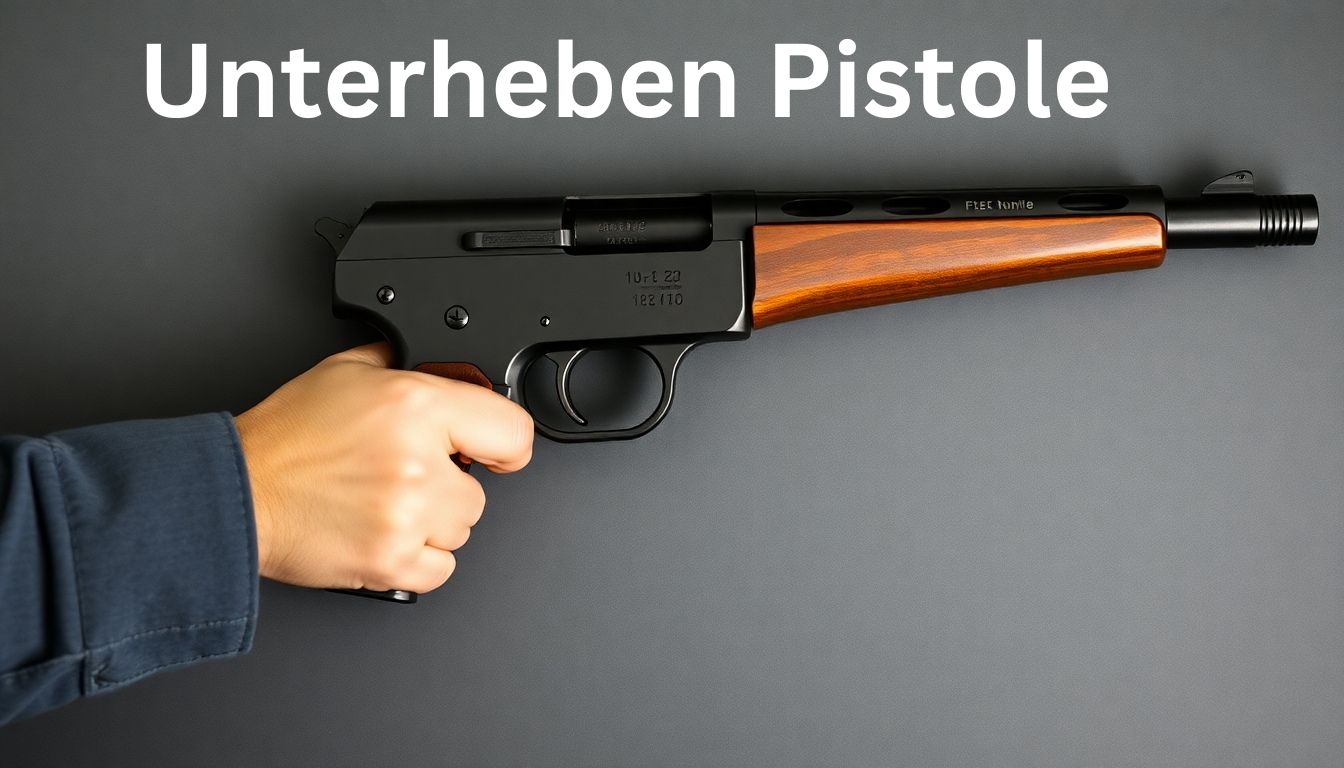The phrase “unterheben Pistole” is a linguistic ghost in the world of firearms. It holds no place within established German (or any other recognized language) vocabulary related to weapons. This very absence, however, becomes a powerful lens through which we can examine the critical importance of precise language when discussing and handling firearms. This detailed exploration will dissect the potential origins of such a phrase, analyze the inherent dangers of imprecise communication in this context, emphasize the necessity of using established terminology for safety and clarity, and provide a deeper understanding of firearm mechanics and safe handling practices.
Deconstructing Unterheben Pistole A Linguistic Anomaly
The Absence of Meaning
A thorough search of firearm manuals, technical documents, legal texts, and online firearm communities reveals no trace of “unterheben Pistole.” The German verb “unterheben” generally translates to “to lift underneath,” “to fold under,” or “to incorporate (into a mixture).” None of these meanings have a direct, logical connection to any known action performed with, or component of, a pistol. This immediately raises questions about the intended meaning, or more accurately, the miscommunication present in the phrase.
Speculative Interpretations and Their Flaws in Firearm Context
While the term “unterheben Pistole” is nonexistent in proper firearm terminology, we can explore potential interpretations, emphasizing that these are purely speculative and not established usage:
- Concealment (Verbergen): A possible, though inaccurate, interpretation is that “unterheben” might be used colloquially to suggest concealing a pistol, perhaps beneath clothing. The idea of “lifting” the garment to place the pistol underneath could be a tenuous link. However, accurate German terms for concealment are “verbergen,” “verstecken,” “verdeckt tragen” (to carry concealed), or “unter der Kleidung tragen” (to carry under clothing).
- Lifting or Drawing (Ziehen/Anheben): Another possibility involves a misinterpretation or misuse of “heben” (to lift). The speaker might intend to refer to lifting the unterheben Pistole from a holster or raising it into a firing position. More appropriate terms are “ziehen” (to draw), “anheben” (to lift), “hochnehmen” (to pick up), or “in Anschlag bringen” (to bring to bear/into firing position). The act of drawing a pistol involves a specific sequence of movements, including establishing a proper grip, clearing the holster, and bringing the weapon to eye level.
- Manipulation of a Specific Part (Highly Improbable): It is extremely unlikely that “unterheben” refers to a specific internal mechanism or part of a pistol. unterheben Pistol have well-defined components with established names (e.g., Abzug – trigger, Hammer – hammer, Magazin – magazine, Verschluss – slide, Lauf – barrel). There is no known part that would logically be described as being “lifted underneath.” The internal mechanisms of a pistol are complex and involve interactions between various parts during the firing cycle, none of which correspond to “unterheben.”
- Figurative Language or Slang (Context Dependent and Dangerous): In highly specific, localized slang or figurative language, “unterheben” could theoretically have a unique, albeit incorrect, meaning. However, without substantial context and a shared understanding within a very small group, this is highly problematic and extremely dangerous in the context of firearm handling. Relying on such obscure terminology creates a significant risk of miscommunication and accidents.
The Critical Importance of Precise Firearm Terminology: Avoiding Unterheben Pistole Pitfalls
The absence of “unterheben Pistole” directly highlights a critical point: precision in firearm terminology is not merely a matter of semantics; it is a fundamental aspect of firearm safety. Misunderstandings arising from incorrect or ambiguous language can have severe, even fatal, consequences.
For example: Confusing “Sichern” (to safe) with “Entsichern” (to unsafely) could lead to an accidental discharge. Using a vague term instead of “Abzug betätigen” (to pull the trigger) could result in unintended firing. Misunderstanding instructions due to imprecise language can lead to improper handling and significantly increase the risk of accidents.
Established Firearm Terminology (German Examples) – Correcting Unterheben Pistole Misconceptions

To emphasize the importance of precision and replace the erroneous “unterheben Pistole,” here are some examples of established German firearm terms:
- Pistole: Pistol
- Revolver: Revolver
- Gewehr: Rifle
- Schrotflinte: Shotgun
- Munition: Ammunition
- Patrone: Cartridge
- Magazin: Magazine
- Abzug: Trigger
- Hammer: Hammer
- Sicherung: Safety
- Laden: To load
- Entladen: To unload
- Zielen: To aim
- Schießen: To shoot
- Holster: Holster
- Visierung: Sights
Also Read: 1926 yellow cadillac cars
The Dangers of Imprecise Communication – Why Unterheben Pistole is Unacceptable
Using non-standard or invented terminology like “unterheben Pistole” creates several significant risks: confusion and misinterpretation, potentially leading to accidents; legal complications due to ambiguity in statements or reports; and severe difficulties in effective training and instruction.
Promoting Clear Communication and Firearm Safety – The Antidote to Unterheben Pistol
To promote firearm safety and prevent misunderstandings, the following practices are essential: consistently use standard terminology from reputable sources, such as official manuals, training materials, and legal texts; actively seek clarification when encountering unfamiliar terms; prioritize clear, concise, and unambiguous language when instructing or communicating about firearms; and commit to continuous learning to stay informed about proper handling and terminology.
Conclusion
The phrase “unterheben Pistole,” while meaningless in established firearm terminology, serves as a crucial reminder of the importance of precise language when dealing with firearms. It highlights the potential for misinterpretation and the dangers of imprecise communication. By adhering to standard terminology, prioritizing clear communication, and promoting continuous learning, we can significantly enhance firearm safety and prevent potentially tragic consequences. The non-existence of unterheben Pistol is not a deficiency but an opportunity to reinforce the vital role of accurate and unambiguous language in the world of firearms. Understanding and using correct terminology is not merely a matter of semantics; it is a fundamental aspect of responsible firearm ownership and handling.



